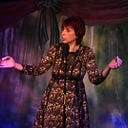Find Good Groups, Tell New Stories To Foster Post-Traumatic Growth
Stories about traumatic life events told in the privacy of my psychotherapy office over the past 30 years have been harrowing, hurt-filled and haunting. And in many cases also startling in the strengths laid bare as their impact was examined, every psychological “muscle” employed to overcome and keep going through adversity identified. The language of trauma — we say we are “falling apart” because what we knew is torn away and our sense of self in fragments — describes how it feels to go through it. It also frames the path for healing — to reconnect to ourselves and community as best we can and to play an active role in telling a coherent story about our experience, who we were and who we are becoming.
When we feel most stripped of personal agency because of events beyond our control, the most important thing is to find support among people who understand the struggle and will not minimize it. Solid support is life-saving, and can be highly rewarding as we come to realize all the ways we contribute to the lives of others even in our darkest hours.
Good groups are alive with the creative force of everyone involved. They provide a safe psychological space for sharing and shaping our story, and science supports this kind of interpersonal experience in the healing and learning process. “We create our selves through narratives…with protagonists and antagonists and a prescribed relationship between narrators, characters and listeners,” states neuroscientist Michael Gazzaniga in “When New Narratives Meet Old Brains” in New Scientist magazine. They have linear plots with a fixed past, a present built coherently on it, and a horizon of possibilities projected coherently into the future.”
Good groups are those in which we can tell the truth, not only our own but the truth about the group itself. We can talk openly about the defenses we all bring to the table but can rarely see in ourselves, and we can look at the dark side of human emotion. We are all blind to some things about ourselves and to aspects of the bigger picture of our lives — that’s just the reality of having a 3-dimensional human brain. But deep engagement with other people and their stories gives us perspective and can reveal possible directions in which to shift our narrative.
Post-traumatic growth happens through these social-emotional experiences because they change our 3-dimensional brain in useful and far-reaching ways. The lasting impact of traumatic events is in the way they shift our perception of life and other people. This transition can shrink our sense of self into a near-constant self-protective posture or propel us into an expanded self that grapples with the truth of what has happened as we try to make sense of it. There can be a natural retreat to feeling anxious and self-protective, a pulling back from new possibilities simply because they are unfamiliar.
Creative experiences in groups — especially ones designed to generate positive social-emotional connections laced with humor and built on a foundation of good will — engage curiosity, discovery, and spontaneity which can then be channeled into generating new roles and an identity grounded in strength. Most importantly, positive group engagement powerfully reinforces new learning and becomes a resource when stress and the pressures of life threaten to sink us once again. According to neuroscientist Donald Hebb, “neurons that fire together, wire together.” Every new experience produces new neural pathways and when we share experiences in groups they produce deep social-emotional bonds and new memories.
Positive bonding in groups-and in couples and families — is the foundation for creating new stories and new roles for growing beyond the pain.
